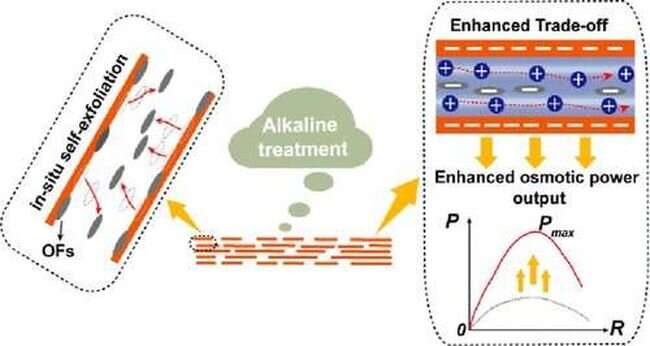Researchers construct nanochannels from graphene oxide nanosheets to harvest ocean osmotic energy

When thinking of renewable energy sources, it is often solar or wind that spring to mind first—but what about ocean energy?
The ocean covers more than 70% of the Earth's surface—providing enormous potential for renewable and clean energy. Institute for Frontier Materials (IFM) researchers hope to unlock this potential.
In a paper published in the Journal of the American Chemical Society, IFM researchers have demonstrated how new advanced two-dimensional (2D) nanomaterial membrane technology can improve blue energy harvesting processes. Blue energy harvesting is a renewable energy that uses the salt content difference between river water and seawater to generate electricity.
"Ocean energy is made up of five forms—tidal, water waves, ocean currents, temperature gradients and salinity gradient energy, offering a potential alternative, limitless energy resource," says Associate Professor Weiwei Lei, who is leading the sustainable energy generation project at IFM.
"Therefore, harvesting ocean energy through artificial devices has attracted tremendous interest. In particular, salinity gradient energy, also called 'osmotic energy' or 'blue energy,' provides significant promise for the development of renewable energy.
"It has a potential 1 TW energy (8500 TW h in a year), which exceeds the sum of hydraulic, nuclear, wind and solar energy in 2015.
"With the development of nanotechnology and 2D nanomaterials, novel 2D nanomaterials' membranes with nanopores and nanochannels were designed for blue energy harvesting.
"However, the energy harvesting efficiency of these membranes is still too low to meet the demands of practical applications due to their high internal resistance and low selectivity of ions.
"New advanced 2D nanomaterial membranes with novel and robust properties will solve this problem, which is in high demand now."
Assoc. Prof. Lei and his team members introduced a strategy to optimize the nanochannels within the 2D nanomaterial membranes to harvest more energy through higher volumes of water.
To do this, researchers constructed nanochannels from graphene oxide nanosheets. The sheets are chemically exfoliated, shaking loose reactive nanosheet fragments called oxidative fragments, which become charged in alkaline conditions. The negatively charged channels attract positive ions in sea water. The osmotic pressure can then "push" the ions through the channels to create a net current that can be harvested.
With this approach, the membrane can overcome the trade-off between permeability (how easily the ions can move through the channels) and selectivity (encouraging only positive ions to move through the channels). This gives Assoc. Prof. Lei's membrane a boost in energy generation compared to graphene oxide membranes that have not been treated to include negatively charged nanosheet fragments.
This strategy boosted the energy generation to levels that could power a small electronic device.
"This means we can harvest more energy through high volumes of water. This boosted energy generation is due to the enlarged nanochannels together with the enhanced local charge density of the detached oxidative fragments."
The new strategy of membrane design using these oxidative fragments to decorate the nanochannels provides an alternative and facile approach for many applications that can exploit the ionic charges, such as ion exchange.
Assoc. Prof. Lei says currently, this research is still limited to laboratory-sized equipment, however they are planning to purchase large facility to fabricate large membrane and device for the large-scale application.
"In the real-world we think that membranes could be installed in river mouths or at exit points for wastewater from industry," Assoc. Prof. Lei says.
"The wastewater from factories or industry has different surface charge ions with a higher concentration than regular water. If we can put our membrane at the end of their processes before the wastewater hits natural waterways we can harvest the energy and also treat that water.
"We are now looking for industry partners who are interesting in the development of new membrane technology for renewable energy generation."
More information: Yijun Qian et al, Boosting Osmotic Energy Conversion of Graphene Oxide Membranes via Self-Exfoliation Behavior in Nano-Confinement Spaces, Journal of the American Chemical Society (2022). DOI: 10.1021/jacs.2c04663
Journal information: Journal of the American Chemical Society
Provided by Deakin University




















